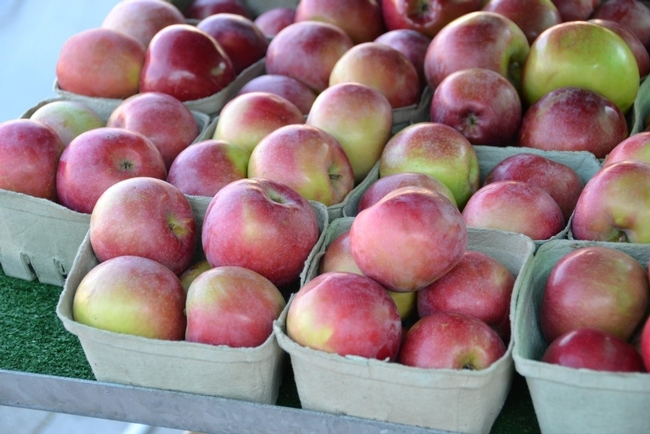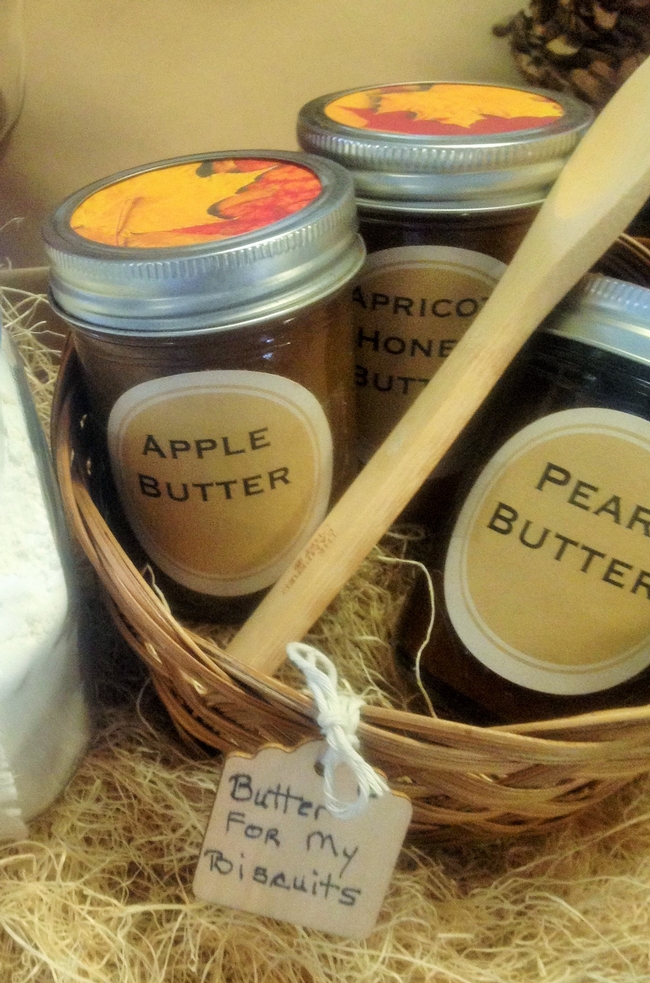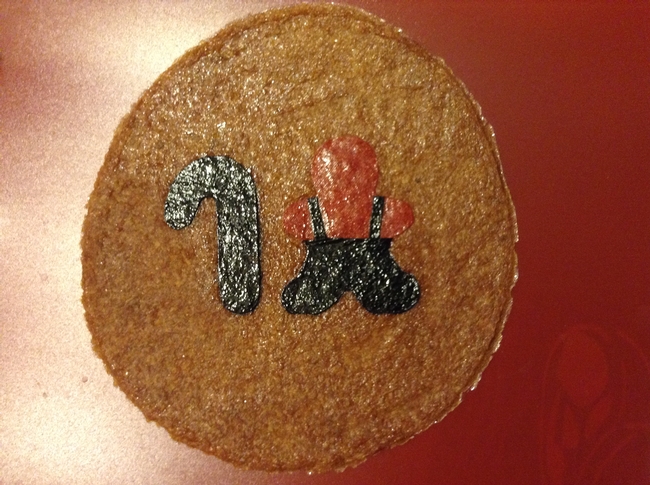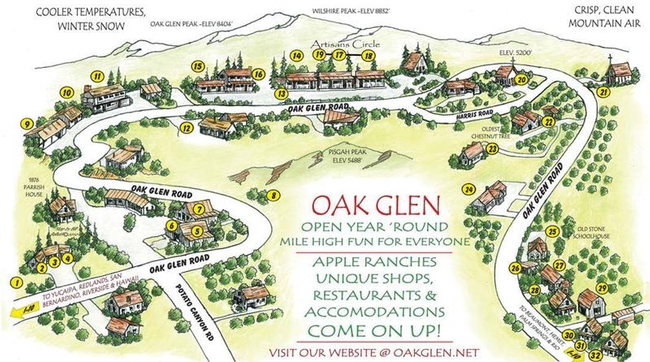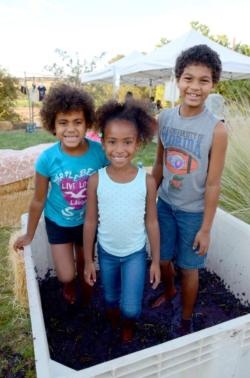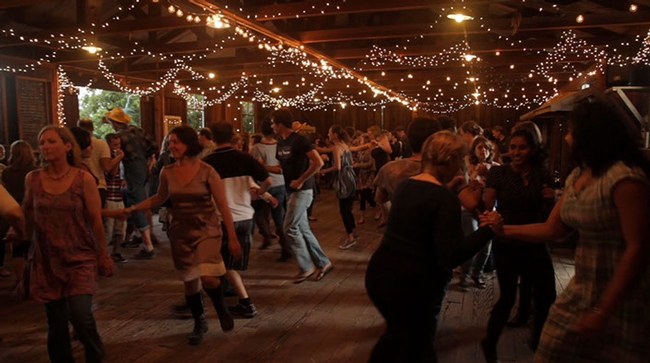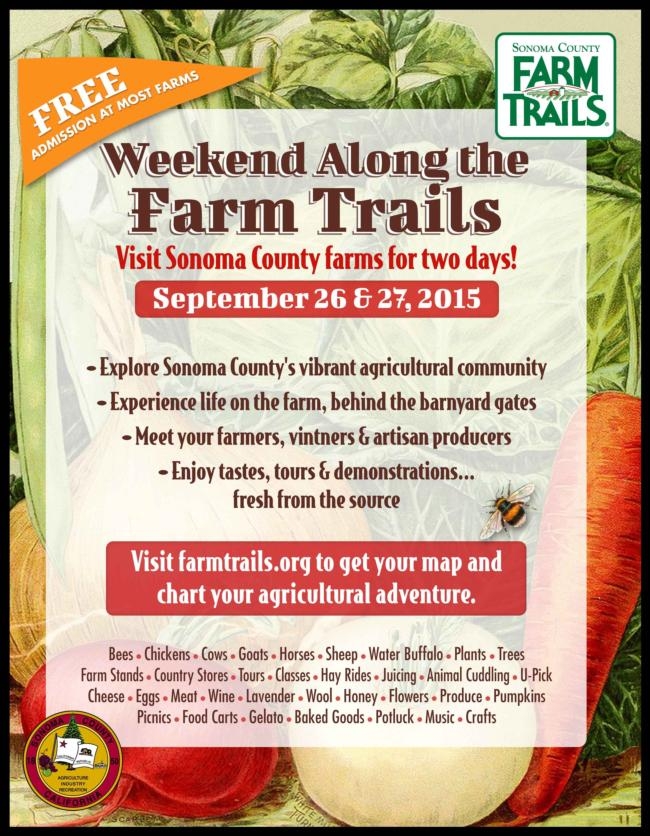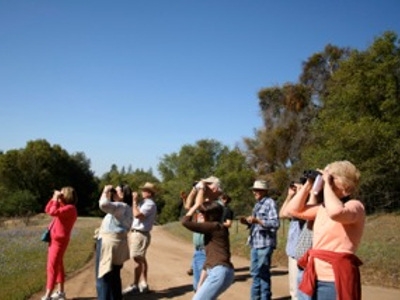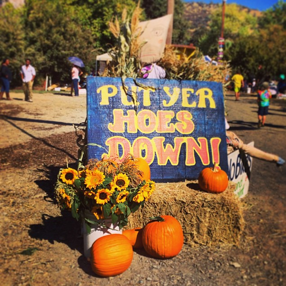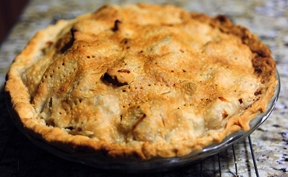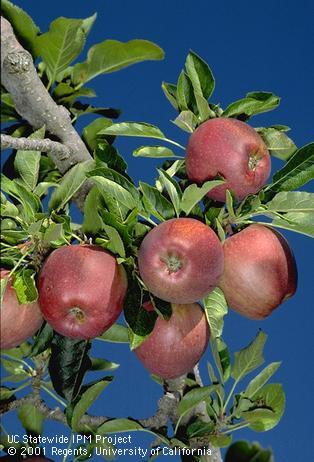Posts Tagged: apples
Apple-tunity: Preserving the fall apple harvest
For some, it's time to wind down the season of preserving, but for others, this time of year provides a field of apple-tunity. Yes, the land of ample – I mean apple – opportunity. Here's a few ideas to get anyone started – no canning skills required!
“Home food preservation of apples and other seasonal fruits and vegetables allows families access to a wider variety of healthy foods throughout the year,” says Missy Gable, co-director for the UC Master Food Preserver Program. “In a time where food preservation is becoming increasingly more popular, it is critical for home preservers to follow research-based methods and recommendations to help ensure the preserved foods are safe for consumption.”
Freezing
To keep it simple, let's look to the freezer as a means to store the apple bounty. There are researched and approved recipes for apple butter, apple jelly, baby food, applesauce, and sliced apples. Even amongst something as simple as sliced apples, you can choose to add some variety in the way you pack them, weather it is in syrup, sugar, or as a dry pack. Syrup packs are good for using in uncooked desserts or fruit cocktail. Sugar and dry packs are perfect for pies. Plan ahead and follow the method that makes the most sense for your season of life.
Dehydrating
Another method for keeping apples is dehydrating. In fact, it rivals freezing in its simplicity. Think rings, wedges and chips. In preparing the crispy treat, remember to pretreat the slices to prevent browning. It can be as simple as making a solution of 2 cups water with 3000mg ascorbic acid (crushed Vitamin C tablets), and dipping the slices for 3 to 5 minutes. Place the apple slices in a dehydrator for six to 12 hours and voila, apple pieces abound for use as granola mix-ins, oatmeal toppings, or a crunchy snack.
In a recent workshop titled “Gifts from the Kitchen,” the UC Master Food Preserver Program of Sacramento County recommended making homemade fruit leather using applesauce. Make your own applesauce, or you can even use store-bought, and convert it into a delicious fruit leather. Smooth the applesauce out to one-eighth-inch thickness over a lined dryer tray or rimmed cookie sheet and dehydrate. Decorate your leather in colors by dyeing with spices such as cinnamon, using red candies or even gelatin. Use cookie cutters to make fruit leather shapes as depicted in the photo. Get creative and have fun; now is the time to let those apples shine!
For more information about apples, download the UC ANR publication Apples: Safe Methods to Store, Preserve, and Enjoy. Detailed recipes and preservation practices alluded to in this article can be found on the National Center for Home Food Preservation site, the Ball site, and in So Easy to Preserve.
If you'd like to learn more in-depth knowledge about safe home food preservation, check out the UC Master Food Preserver Program. They hold public classes by county as well as extensive training programs for qualified applicants.
Celebrate the harvest - visit a farm
All over California, farmers are harvesting the last summer crops, picking apples, crushing grapes, and watching pumpkins ripen. All over California, farmers also welcome the public to enjoy family-friendly harvest festivals, education and entertainment. To help urban and suburban Californians connect with local farms and agricultural events, UC Agriculture and Natural Resources (UC ANR) hosts the UC Agritourism Directory.
Here is a sampler of harvest season fun on the farms this month:
Apple Hill Growers' Association - El Dorado County
About 50 years ago, when a pear blight destroyed the pear crop in the El Dorado County foothill region near the small town of Camino, UC Cooperative Extension pomology specialist and farm advisor Ed Delfino worked with local growers to save their ranches. They began to plant apples, formed the Apple Hill Growers' Association and started inviting their neighbors from the valley to visit the farms for fresh apples and fun. Since the time of the group's first apple press and press picnic in 1964, the original ranch marketing association has blossomed into a very successful ranch marketing endeavor.
Today, Apple Hill includes over 55 ranchers, including Christmas tree growers, wineries, vineyards and a spa. For 50 years, Sacramento region families, along with those from the east side of the Sierras, have made a tradition of driving up Highway 50 to enjoy picking apples, drinking wine, arts and crafts, pies, jams, jellies, music, and other activities. Visitors will find their day filled with old-fashioned fun.
The ranches are now open, with U-Pick orchards, entertainment, crafts, food and events at multiple locations. Learn more at www.applehill.com/.
For current information, download the free official Apple Hill™ app available through itunes or in the Google Play Store.
Oak Glen Apple Growers Association - San Bernardino County
Oak Glen is where the Apple Hill growers visited to learn how to share their apple harvest with the public, back in 1964. One of the most scenic spots in Southern California, Oak Glen is nestled in the heart of Apple Country, where it is cooler in the summer and winter offers snow. An hour or so from Los Angeles or Palm Springs, the 30 members of the Oak Glen Apple Growers Association offer a pleasant day trip or weekend away from town.
Visit orchards, pick fresh apples and drink fresh-pressed cider, and enjoy hot apple pie and other fresh baked apple treats at one of the family restaurants. Other attractions include an animal park, the Wildlands Conservancy, horse drawn wagon rides, the historical Oak Glen School House Museum and many activities offered by the different farms.
For apple picking and other fun: www.oakglen.net/
Grape Stomping, food, drink and fun in the Capay Valley, Yolo County - September 19, 2015
The 5th Annual Capay Crush will take place on Saturday, Sept. 19, 2015, from 4 p.m. to 9 p.m. in the beautiful Capay Valley, with a full slate of activities for all ages, including live music from Hot City Jazz and Dirty Cello, wine tasting, local food and grape stomping. Attendees are invited to camp overnight in the farm orchards. Event proceeds benefit the Kathleen Barsotti Non-Profit for Sustainable Agriculture (KBNP).
Guests can step into a vat of grapes and stomp until their feet are purple. Visitors can also ride the farm's tractor tram, enjoy free honey and olive oil tastings, take part in grape-themed activities and crafts, visit the petting zoo, and take a self-guided walking tour of Capay Organic.
Tickets are on sale now through Sept. 17, for $15 per person (children ages 12 and under are free) or 4 tickets for $50. After Sept. 17, tickets will be sold at the farm for $20 per person. Guests can also camp overnight at the farm in the orchards. Campsites can be reserved in advance for $35 each at www.capaycrush2015.eventbrite.com by Sept. 17 (admission not included).
To purchase tickets, go to: www.capaycrush2015.eventbrite.com. Call 1-800-796-6009 with any questions.
Work Day & Barn Dance at Pie Ranch by the coast - Pescadero, September 19, 2015
Pie Ranch is a small working farm by coastal Highway 1 that cultivates a healthy and just food system, from seed to table. Celebrate the spirit of community at this monthly ritual of touring or working together on the ranch, sharing locally grown food, and then spinning, laughing and dosey-doing together into the night.
RSVP for the work day and/or barn dance by emailing simone@pieranch.org. Private groups of more than 10 are encouraged to schedule a separate tour/program with the farm as they are attempting to keep the dance open and accessible to the greater community.
The work day begins at 2 p.m. Park past the roadside barn and check in at the roadside barn. The tour begins at 4 p.m. Entry is $10 to 20 per person, charged on a sliding scale. Pay at the Roadside Barn. A potluck dinner begins at 6 p.m. The event is alcohol free. The barn dance is from 7 to 10 p.m. Entry is $12 to 20 (sliding scale).
Children under 12 are free. More information on the work day and barn dance here.
News flash from Pie Ranch: "We planted the tomato plants in the spring and now we are up to our ears in tomatoes! While the summer bounty lasts, we will be holding our Cherry Tomato U-Pick everyday! Between 10 a.m. and 3 p.m., you are welcome to stop by the ranch and pick cherry tomatoes right off the vine!
Weekend Along the Farm Trails - Sonoma County - September 26 & 27, 2015
On Saturday and Sunday, Sept. 26 and 27, 2015, Sonoma County farmers will open their gates and barn doors to offer a behind-the-scenes peek at life on the farm.
Most of the stops are free.
All you need is transportation, a map of your route, a cooler to keep your purchases fresh, and a sense of adventure! Register now for your chance to
~ Explore Sonoma County's vibrant agricultural community.
~ Experience life on the farm behind the barnyard gates.
~ Meet your farmers, vintners & artisan producers.
~ Enjoy tastes, tours, & demonstrations fresh from the source.
Please note that some farms are only open one day. Feel free to contact the organizers with questions: farmtrails@farmtrails.org.
Please let the organizers know how many people will be in your car by selecting the corresponding number of tickets. Register now
Bloomingcamp Ranch Harvest Festival - Oakdale - September 26 & 27, 2015
Admission is free for this small farm festival near Modesto. Bring the family for live entertainment, chef demos, hayrides, games, kids art patch, pie eating contest, petting zoo, local arts and crafts and a car show. It all happens at Bloomingcamp Ranch, 10528 Highway 120, in Oakdale. For more information: www.bloomingcampranch.com or (209) 847-7437
Farm and Ranch Tour in the Sierra foothills - Mariposa County - September 26, 2015
The Mariposa AgriNature Association invites you to enjoy the bounty of their beautiful foothills. Experience the diversity of California's Sierra Foothills near Yosemite National Park.
The 2015 farm and ranch tour features four farm and ranch locations, along with a special display of the UC Master Gardeners near downtown along the Creek Parkway. Each location will showcase their unique agricultural operations, and vendors and artists will be set up as well.
Tickets are $10 per person, or $25 for a whole car. Kids under 12 are free when accompanying a paying adult. Tickets may be purchased at any tour location and are good for all locations. website/more info
Hoes Down Harvest Festival - Capay Valley, Yolo County - October 3 & 4, 2015
Join 5,000 festival attendees and 200 volunteers on the 300-acre organic Full Belly Farm for a full day, or a weekend, of fun, music, activities and education for all ages.
On Saturday, enjoy live music, circus performances, kids arts and crafts, a kids hay fort, contra dancing, agricultural workshops, farm tours, good food, a crafts fair and farmers' market, and more music. The silent auction features a range of affordable treats.
Camping is available on Saturday night in the walnut orchard, with breakfast and longer workshops and activities offered on Sunday.
All of the proceeds from the Hoes Down Harvest Celebration go to non-profit organizations that support sustainable agriculture and rural living.
Admission Prices:
Adults: $20 when purchased online – $25 at the gate.
Children (2-12): $5
Under 2: Free
Saturday Night Camping: $25 per car – No reservations needed.
website, tickets, more info
For more info about these events and more California farms and ranches to visit, see www.calagtour.org
Author: Penny Leff
The fruits of their labors
Summer time...and the livin' is easy.
But not for the bees. Worker bees, which live about four to six weeks, literally work themselves to death gathering nectar, pollen, propolis (plant resin) and water to bring back to their colony.
So, when you sit down to summer meals, you can thank a bee.
Extension apiculturist Eric Mussen of the UC Davis Department of Entomology and Nematology, says one-third of the American diet is pollinated by bees. Without bees, we'd be eating such wind-pollinated grains as wheat and rice.
Our gardens and orchards yield such favorites as carrots, cucumbers, onions, apples, grapefruit, oranges, pears, cherries, raspberries, strawberries, blueberries, lima beans, sunflowers and almonds.
All pollinated by honey bees.
Cole crops, such as cabbage, Brussel sprouts, collards, kale, kohlrabi, spinach, chard and broccoli?
All pollinated by honey bees.
Even milk and ice cream are linked closely to the honey bee. Cows feed on alfalfa, which is pollinated by honey bees (along with other bees). Ice cream ingredients usually include fruits and nuts, other bee favorites.
The ever-popular fruit salad features blueberries, apples, oranges and pomegranates.
All pollinated by honey bees.
An apple a day may keep the doctor away, but without the bees, we'd have no apples.
Love apples and honey? Here are two recipes from the National Honey Board celebrating both honey and apples.
Apple honey crisp
2 lbs. apples, quartered and sliced (1-1/2 quarts)
1/2 cup plus 1/4 cup honey, (separated)
1 teaspoon cinnamon
1/2 teaspoon nutmeg
1 cup flour
1/4 cup butter, softened
Warm Nutmeg Cream, (recipe follows) or ice cream
Toss apples with 1/2 cup honey, cinnamon and nutmeg in bowl. Turn into 2-quart baking dish. For topping, beat flour with butter and 1/4 cup honey until crumbly; sprinkle over apples. Bake at 350 degrees for 40 to 45 minutes or until apples are tender and topping is golden. Serve with warm nutmeg cream or ice cream.
Warm nutmeg cream
1/2 cup whipping cream
2 tablespoons honey
2 tablespoons butter
1/4 teaspoon nutmeg
Combine all ingredients in saucepan and bring to boil. Simmer, stirring often, for 5 minutes or until mixture thickens slightly.
Honey apple cake
1/3 cup butter or margarine
1/3 cup packed brown sugar
2 eggs
1/3 cup honey
1 teaspoon grated lemon peel
1-1/2 cups flour
1 teaspoon baking powder
1/2 teaspoon baking soda
1/2 teaspoon ground cinnamon
1/4 teaspoon salt
1/4 teaspoon ground nutmeg
1/8 teaspoon ground allspice
1/4 cup water
1 cup (1 medium) pared, cored, & chopped apple
1/4 cup chopped walnuts
Honey Apple Topping
Cream butter and sugar until light and fluffy. Add eggs, one at a time; beat after each addition. Beat in honey and lemon peel. Combine flour, baking powder, soda, spices and salt; mix well. Add to creamed mixture alternately with water; begin and end with dry ingredients. Stir in apples and nuts. Turn into greased and floured 9-inch heart-shaped or round cake pan. Bake at 325 degrees F. for 45 to 55 minutes or until wooden toothpick inserted near center comes out clean. Cool 10 minutes and remove from pan. Cool completely. Brush top of cake with sauce from honey apple topping; arrange topping on cake.
Honey apple topping
1/3 cup honey
2 tablespoons rosé wine
2 tablespoons lemon juice
2 medium apples
Heat honey, rosé wine and lemon juice. Core and slice 2 medium apples; add to honey. Cook until tender and glazed; turn slices halfway through cooking. Makes topping for one 9-inch cake.
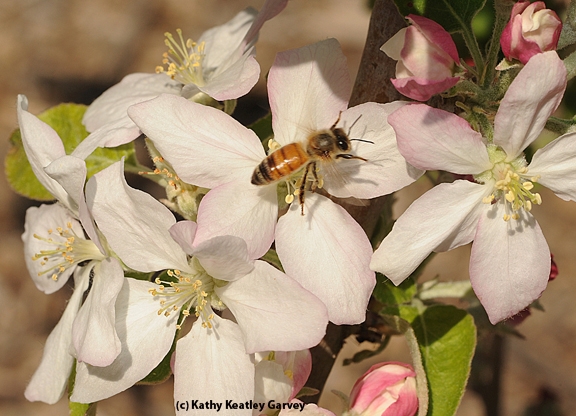
Honey bee pollinating apple blossom. (Photo by Kathy Keatley Garvey)
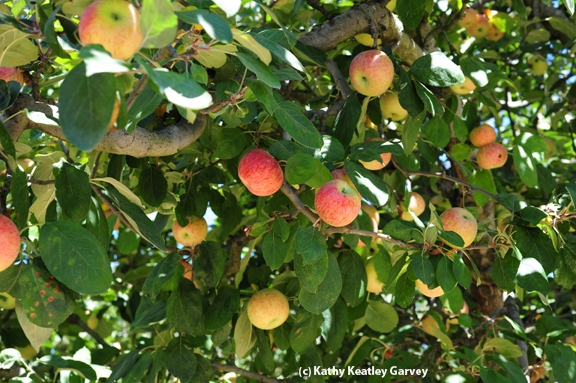
Gravenstein apples ready to be picked. (Photo by Kathy Keatley Garvey)
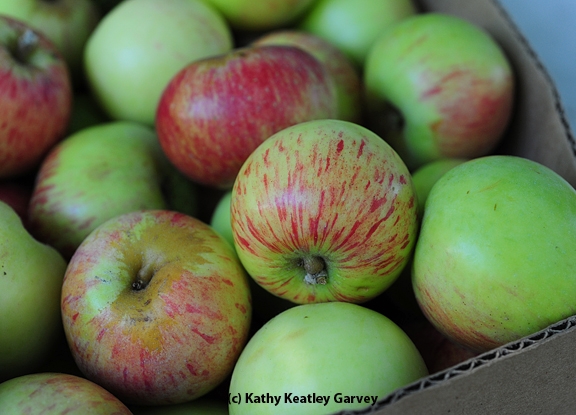
Gravenstein apples ready to eat. (Photo by Kathy Keatley Garvey)
Cherish the Gravenstein
If an apple a day keeps the doctor away, what does a Gravenstein apple pie do?
It causes a stampede to the dining room table, that's what it does. Expect to see chairs overturning, plates flying and forks spinning.
That's because Gravensteins make the best pies. As any apple pie aficionado will tell you: the best pies are the "G" pies: Gravenstein (first) and Granny Smith (second).
The Gravenstein apple reigned as the preferred apple on our family farm in western Washington. We found the sweet-tart apple "perfect" for eating right off the tree, or made into pies, applesauce and apple cider. The cows liked them, too. A gentle nudge on the tree, and - eureka! - apples would magically fall to the ground. Talk about happy cows!
This heirloom apple also reigns supreme in Sonoma County. Just ask the Gravenstein apple farmers, area residents, restaurants and the tourists who line up to buy a bag or two.
That's because of its flavor, its propensity for being in the right place (pie) at the right time, and its short season make it even more treasured. Plus, this is an apple with an aroma. The delightful fragrance will permeate your kitchen.
It's a short, squatty looking apple, streaked with red. Sometimes Nature's paintbrush turns the thin streaks into thick bands. And the stems are short - so short and so susceptible to falling from the tree that, "growers estimate they lose 40 percent of their apples even before they are ripe," wrote Carolyn Jung of The Day newspaper, New London, Conn., in her interview with Paul Vossen, UC Cooperative Extension advisor in Sonoma and Marin counties, for a Sept. 8, 1999, article.
First described in 1797, the Gravenstein originates from Denmark, where it's known as "Gråsten." It took a couple of centuries to do it, but in 2005, Denmark declared it the "national apple."
How did it get to Sonoma County? Russian trappers first planted it there in 1811. The good citizens of Sonoma so liked the apple that they named a major artery the "Gravenstein Highway." Over the last six decades, however, "Sonoma County's Gravenstein orchards have declined by almost 7,000 acres and are currently down to 960 acres," according to an article on the Slow Food USA website.
Why? Farmers find it more profitable to grow grapes.
Also, it's not an easy apple to market. It's an early variety with a very short season, usually during a few weeks in August. Blink and it's gone.
And, it's an apple you won't find in your local produce section, tucked among the Red Delicious, Galas, Fujis, Pink Ladies and Granny Smiths.
"They don't travel well, and they don't last long (short season)," says Daniel Sumner, professor in the Department of Agricultural and Resource Economics at UC Davis and director of the UC Agricultural Issues Center. "To consumers, this is the kiss of death."
Enter the Slow Food movement. To help preserve the heirloom apple, the Russian River Slow Food group contacted area restaurants and asked that it be featured in their desserts. Getting into the preserve-the-Gravenstein act, the FruitGuys, a company that ships organic fruit to customers, donated 17 percent of this year's proceeds back to the Gravenstien apple farmers.
Every little bit helps.
In the meantime, Sebastopol continues to celebrate its annual Gravenstein Fair; this year the event took place Aug. 11-12.
In search of Gravensteins, we drove to Sebastopol on Sunday, Aug. 19, just as the season was about to end. "Ours will be gone in a couple of days," a farmer told us.
"Which apple makes the best pie?" we asked. "Granny Smiths or Gravensteins?
"Gravensteins," the farmer said. "Hands down."
We agree.
Here's our family recipe for Gravenstein apple pie. We favor using brown sugar instead of granulated white sugar. And we mix the brown sugar with cinnamon and nutmeg.
Crust for 9.5-inch pie
2 cups flour
1/2 teaspoon baking powder
2/3 cup butter-flavored Crisco, chilled
3/4 teaspoon salt
6 tablespoons water, cold
Sift flour, baking powder and salt. Mix in Crisco until the dough pieces are pea-sized. Add cold water as needed, 6 tablespoons or more, and form into a ball. Roll out dough into a circular shape and invert on pie pan.
Filling for 9.5-inch pie
8 cups of apples, peeled, cored and sliced
1 teaspoon cinnamon
1/2 teaspoon nutmeg
3/4 cup loosely packed brown sugar
1-1/2 tablespoons of butter
Preheat oven to 425 degrees. Gently mix together (with fork) brown sugar, cinnamon and nutmeg and then mix lightly through the apples. Before pouring the mixture into the pie pan, sprinkle a little cinnamon (less than 1/4 teaspoon) on the lower crust. Dot the heaping apple mixture with thin slices of butter. Place top crust on pie. Slit with sharp knife in several places and poke with prongs of fork. Sprinkle a dash of nutmeg on the crust. Line the edge with 1/2-inch strip of aluminum foil to prevent excessive browning. Bake at 425 degrees about 50 minutes or until the crust is lightly browned and the apples are cooked through. Test with fork.
Warning: the aroma of this pie will attract all the neighbors, their families, their friends and their friends' friends.
No wonder Luther Burbank said that “if the Gravenstein could be had throughout the year, no other apple need be grown.”
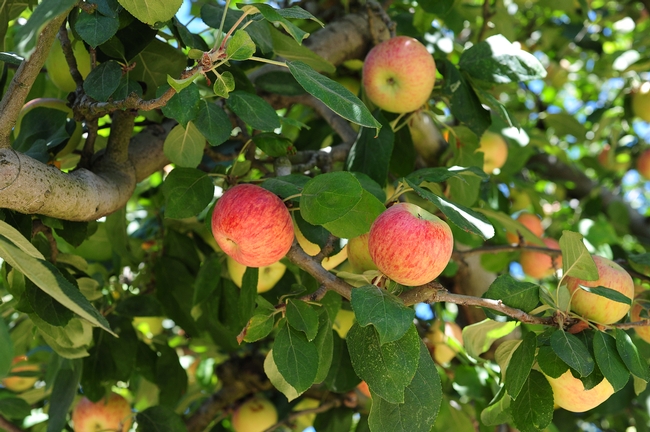
Gravenstein apples hang from a tree in Sonoma County. (Photo by Kathy Keatley Garvey)

Gravensteins are usually streaked with red, but Nature's paintbrush created this effect. (Photo by Kathy Keatley Garvey)
Apple time!
Remember that snow on the foothills back in May? That cold spell delayed the apple harvest in El Dorado County about 10 days, but the ranches of the Apple Hill Growers Association are now open for visitors. Gravensteins are already ripe and the first crisp and juicy Galas are ready to pick, with Jonagolds close behind. September is the perfect month to visit the ranches, pick your own apples and maybe stop for a glass of wine or a slice of fresh apple pie.
More than 50 Apple Hill Association member ranches welcome the public onto their small foothill farms every fall with fruit stands, U-pick opportunities, wineries, apple pressing, bake shops, and attractions including live music, old-time steam engines, craft fairs, apple-head carving classes and pie-eating contests. The association hosts a website to help visitors find farmstands, where to pick their own fruit or what events are scheduled.
Apple Hill was born of hard times. In the 1960s, pears were the chief source of income for the area. But a disease known as "pear decline" was ravishing the trees. A small group of local farmers met with the UC Cooperative Extension farm advisor and the county agricultural commissioner to discuss how to save the farms. Since most of the farms had a few apple trees on the land, they decided to try inviting people from the Sacramento Valley up the hill to buy some apples and a fresh-baked pie or two as a stop-gap measure until they could figure out a solution. The apple and pie event was instantly successful, the growers formed their association and planted more apple trees, and Sacramento Valley families have made a tradition of the short drive to Apple Hill every fall for the past 50 years.
All over California, apple growers are harvesting now. California is fifth in the United States in apple production, and many of California's growers have organized together to share their harvest season directly with visitors. In San Bernardino County, about 90 minutes from Los Angeles, The Oak Glen Apple Growers Association offers U-pick apples, U-press cider, hayrides, farm animals, tours and history. In Sonoma County, you can check the Sonoma County Farm Trails to find an apple ranch to visit. To find other apple ranches, check the California Apple Commission's site.
When you do pick your own apples at one of the many ranches open to the public, you may be pleasantly surprised to learn that you don't have to climb any ladders. In fact, due to liability concerns, most U-pick operations now make sure that you keep both feet firmly on the ground by planting dwarf varieties of fruit trees for visitors' picking.
Just picked, crisp sweet apples can't be beat for good eating. They are also good for you; an apple a day just might help keep the doctor away. apples are very low in saturated fat, cholesterol and sodium, and are a good source of dietary fiber and vitamin C.
Apples will keep for three or four months, or even longer if stored properly. When harvesting, do not remove the stems from apples that will be stored. Be sure to store only apples without bruises, insect or disease damage, cracks splits or mechanical injury. Store apples at around 40 degrees F for best results. You may also want to wrap each apple in newspaper to keep them from touching each other.
Apples are also great for cooking. Here's an apple crisp recipe from www.momswhothink.com:
Mama Shirley's Apple Crisp Recipe
Apple Crisp Ingredients :
12 medium Granny Smith & Macintosh apples (6 of each); peeled, cored and sliced
1 teaspoon vanilla
1 cup all-purpose flour
2 cups rolled oats
1 1/2 teaspoon ground cinnamon
3/4 teaspoon ground nutmeg
1 1/2 cups packed dark brown sugar
1 1/2 cups butter, softened
Apple crisp directions:
- Preheat oven to 350 degrees F (175 degrees C).
- Place apples in a mixing bowl, sprinkle evenly with vanilla. Toss to combine.
- In a large bowl, combine the flour, oatmeal, cinnamon, nutmeg and brown sugar. Cut butter into mixture until crumbly.
- Evenly place coated apple slices into the bottom of a greased 9x13 inch baking dish. Cover apple slices with crumb mixture.
- Bake at 350 degrees F (175 degrees C) for 45 to 50 minutes or until apples are tender.


